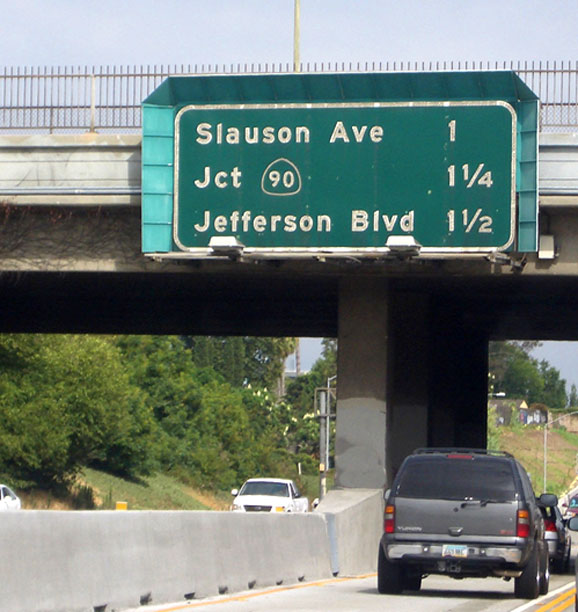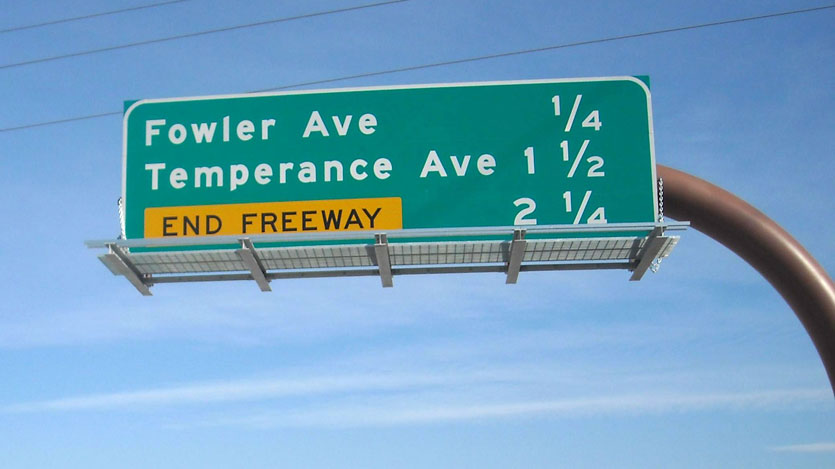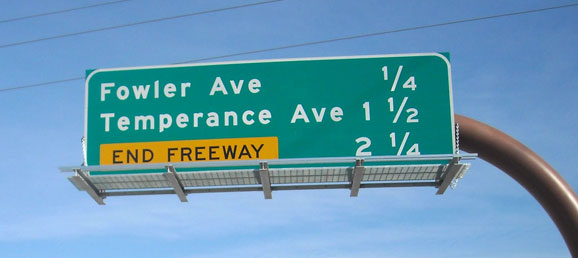- How can you tell which exit is closest to you?
- How can you tell which exit is farthest from you?
- How would you show how far apart the freeway exits are on a map?
- Which exits are closest together?
- How far apart are the freeway exits?
- What are the fractions measuring?
- What units are the fractions measuring in?
- Does anyone have the same answer but another way to explain it?
- Can you make a model and show that?
These challenges may seem too easy, but they often bring out many misconceptions. As an example, many years ago after spending a week working with a class of sixth graders on operations with fractions, I gave them the picture below and asked them “How far apart are Jct 90 and Jefferson Blvd?”

I thought I would have a classroom of students telling me “1/4 mile” and while some students did state that, I had far more that said:
- “1/3 mile” (because 1/3 is between 1/4 and 1/2)
- “2 3/4 miles” (apparently adding the two distances seemed logical to them)
- “1/4” (no units, so one fourth of what?)
Then, to make this experience even more profound, the next day I gave students the same problem without the context:
1 1/2 – 1 1/4
Almost the entire class correctly answered with 1/4! It blew me away that I had created a class of students who had such shallow knowledge that a problem they had mastered procedurally was beyond them when presented in context. It was a very important moment in my career that helped me realize the necessity of presenting students with real-world contexts to help them develop rigorous mathematical understandings.
Don’t forget to make sure students attend to precision and “are careful about specifying units of measure.” (Math Practice 6)
- Option 2

- Option 3

- Option 4

- CCSS 3.NF.2 Understand a fraction as a number on the number line; represent fractions on a number line diagram.
- CCSS 3.NF.2b Represent a fraction a/b on a number line diagram by marking off a lengths 1/b from 0. Recognize that the resulting interval has size a/b and that its endpoint locates the number a/b on the number line.
- CCSS 4.NF.2 Compare two fractions with different numerators and different denominators, e.g., by creating common denominators or numerators, or by comparing to a benchmark fraction such as 1/2. Recognize that comparisons are valid only when the two fractions refer to the same whole. Record the results of comparisons with symbols >, =, or <, and justify the conclusions, e.g., by using a visual fraction model.
- CCSS 4.NF.3a Understand addition and subtraction of fractions as joining and separating parts referring to the same whole.
- CCSS 4.NF.3c Add and subtract mixed numbers with like denominators, e.g., by replacing each mixed number with an equivalent fraction, and/or by using properties of operations and the relationship between addition and subtraction.
- CCSS 4.NF.3d Solve word problems involving addition and subtraction of fractions referring to the same whole and having like denominators, e.g., by using visual fraction models and equations to represent the problem.
- CCSS 5.NF.1 Add and subtract fractions with unlike denominators (including mixed numbers) by replacing given fractions with equivalent fractions in such a way as to produce an equivalent sum or difference of fractions with like denominators. For example, 2/3 + 5/4 = 8/12 + 15/12 = 23/12. (In general, a/b + c/d = (ad + bc)/bd.)
- CCSS 5.NF.2 Solve word problems involving addition and subtraction of fractions referring to the same whole, including cases of unlike denominators, e.g., by using visual fraction models or equations to represent the problem. Use benchmark fractions and number sense of fractions to estimate mentally and assess the reasonableness of answers. For example, recognize an incorrect result 2/5 + 1/2 = 3/7, by observing that 3/7 < 1/2.
- Freeway signs



Great lesson –I need more like this to teach more contextual math to my third graders. Thank you!